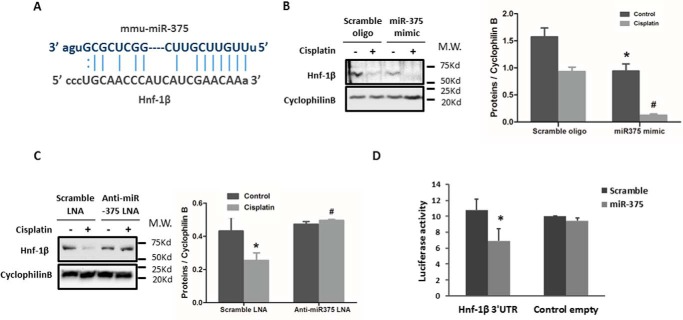FIGURE 6.
miR-375 targets HNF-1β during cisplatin treatment. A, the predicted, conserved miR-375 binding site in 3′-UTR of HNF-1β mRNA. B, immunoblot analysis showing the repressive effect of miR-375 on HNF-1β expression. RPTC cells were transfected with miR-375 mimic or scrambled RNA oligo for 24 h and then treated with or without 20 μm cisplatin to collect whole cell lysate for immunoblot analysis of HNF-1β. Cyclophilin B was used as internal control. C, immunoblot analysis showing that anti-miR-375 LNA preserved HNF-1β expression during cisplatin treatment. RPTC cells were transfected with anti-miR-375 LNA or scrambled LNA for 24 h and then treated with or without 20 μm cisplatin. Whole cell lysates were collected for immunoblot analysis of HNF-1β and Cyclophilin B was used as internal control. The blots were quantified by densitometry. D, microRNA target reporter assay of HNF-1β 3′-UTR. The putative miR-375 binding sequence of the HNF-1β 3′-UTR was cloned into the pMIR-REPORT plasmid to analyze luciferase activity after miR-375 mimic transfection, compared to the scramble control. β-gal was co-transfected for normalization. miR-375 mimics transfection only reduced luciferase expression in pMIR-REPORT HNF-1β 3′-UTR sequence. Data were expressed as mean ± S.D. (n = 3); *, p < 0.05 versus empty vector control with scramble transfection.

